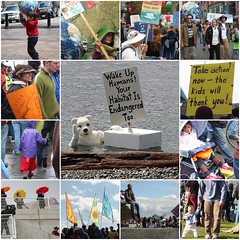“The Weather Makers,” a book by Tim Flannery, is one of the best sources for those who want to understand the global heating process that is seriously destabilizing the world’s climate. In it, Flannery explains the three main Continue reading
Stepping it Up … second time around …
Global Warming is a massive challenge. It requires serious commitment for change toward a better tomorrow, change from government and from individuals. Government action can help drive (and facilitate) individual  action. And, well, individual action — individuals acting in concert — can help drive government action.
action. And, well, individual action — individuals acting in concert — can help drive government action.
That second, individuals combining to drive a government response, is the core to Step-It-Up. And, after a massive set of actions earlier this year (1400 rallies across the nation), Bill McKibben is organizing another day of citizen engagement for 3 November 2007. This is something that everyone (EVERYONE) should engage with …
Global Warming deniers follow tobacco industry tactics
The current issue of Newsweek has an excellent article that follows the myths and motives of the Global Warming deniers. I urge you to read it as it demonstrates how the argument against accepting the reality of Global Warming is created by the people who have the most to gain from ignoring it. Most interesting to me is the following quote:
“They patterned what they did after the tobacco industry,” says former senator Tim Wirth, who spearheaded environmental issues as an under secretary of State in the Clinton administration. “Both figured, sow enough doubt, call the science uncertain and in dispute. That’s had a huge impact on both the public and Congress.”
cross-posted at www.local-warming.blogspot.com
Bogota leads the way in planning cities
“A protected bicycle path is a symbol that a citizen on a $30 bicycle is equally important as one in a $30,000 car.” –Enrique Pe
Bush to host climate talks
I learned from the BBC today that President Bush has invited the UN and EU plus 15 of the world’s leading economies to join him September 27-28 to talk about climate change. Bush of course is asking for the big emitters to enter into a gentleman’s agreement about voluntary reductions, which is the same plan he mentioned at the G8 back in June. Bush also claims that “this would then contribute to a global agreement under the UN Framework Convention on Climate Change by 2009.” This treaty would replace Kyoto. Let’s see- Bush hates the Kyoto Protocol and he doesn’t believe in mandatory limits on emissions.
House passes energy bill, Bush set to veto
The Washington Post published an article yesterday reporting that the House passed an epic energy bill on Saturday that includes a 15% renewable energy standard. The bill passed 241 to 172 and also includes:
- more energy efficiency in appliances, buildings and power grids, which proponents of the bill say would reduce carbon dioxide emissions and electricity use
- more energy efficiency measures in the Capitol building
- grants for studies to promote ethanol pipelines
- installation of pumps for 85 percent ethanol fuel at gas stations
- production of cellulosic ethanol.
According to the Post:
The House last night also passed, 221 to 189, a companion tax package, totaling nearly $16 billion, that targets the oil and gas industry. In a letter to Congress, however, the Bush administration said Friday that the two House measures would result in less domestic oil and gas production. The letter said President Bush‘s senior advisers would recommend that he veto the bills.
Here is what did not make it to the bills, which may occur later this year in a reconciliation of House and senate energy bills, or in a global warming bill:
- other mandates for renewable energy
- incentives for coal-to-liquid production (thank GOD- that stuff has twice the CO2 emissions of gasoline)
- tougher vehicle fuel-economy standard (heavily opposed by UAW)
cross-posted at www.local-warming,blogspot.com
rebuttal to liquefied coal article
Lowell Miller’s column arguing in support of liquefied coal as an energy source was disturbing and irresponsible.
Mr. Miller claimed that carbon sequestration has rendered concerns over liquid
coal’s pollution obsolete. That is simply untrue. Carbon sequestration is not reliable technology on a commercial scale.
Some climate experts say we have ten years to stabilize, then reduce, greenhouse gas emissions in order to avoid the worst consequences of global
warming. Subsidizing coal to liquid technology would be a giant step in the wrong direction.
According to the Natural Resources Defense Council, every gallon of liquid coal burned would generate twice the carbon emissions generated by a gallon of gasoline derived from petroleum.
If we want our children to have a chance at inheriting a planet without melted polar ice caps, coastal flooding, unpredictable weather patterns and
the chaos and poverty this entails, we must vote now for energy policies that strive for energy independence created by clean, alternative energy technologies such as wind, solar and bio-diesel power.
A future based on clean energy independence means a future of better global health and security. I am proud of leaders like Gov. Martin O’Malley, who has recently formed a commission to reduce Maryland greenhouse gas pollution 15 percent per capita by 2015 .
This necessary goal is achievable if we are willing to make voluntary changes to reduce our carbon footprint and demand legislative changes that move us toward an energy policy based on clean, renewable energy.
Katherine Hinckley
Towson
Another Missed Opportunity
Once again, our caring and trustworthy elected officials will take up debate on the Energy Act of 2007
Act NOW to change America: Key House vote TODAY!
The House is considering, amid all the energy legislation, instituting a nation-wide renewable power standard (RPS). HR969 is up for a vote TODAY! Continue reading

